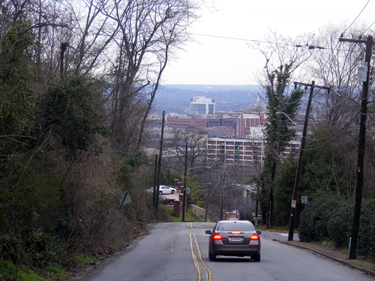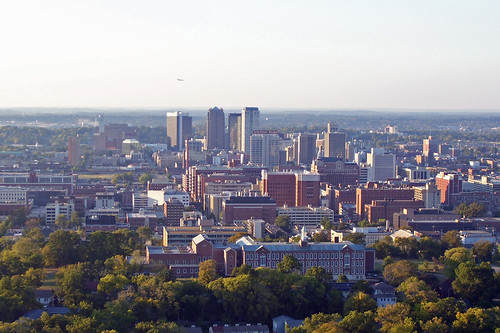Something that seems to escape the minds of many of the people from all sides of the continuing debate about a future use of the former Carraway Hospital complex is the significance of 24th St. It may mean nothing to those who don’t normally find themselves exploring the Magic City during business hours, but it should.
See, 24th Street is one of the few that connects the area near the entertainment complex with points east. Specifically, you can drive 24th Street from the back side of the Carraway property and eventually you’d end up on Montclair Road (formerly U.S. 78) and eventually Crestwood Boulevard (the current U.S. 78). This also means it’s one of the only non-Interstate routes out to The Shops at Grand River (though that’s the topic of another post…).
A city that has a love/hate relationship with highways may not see the immediate impact of this situation. The same cannot be said for a city working to become a 21st century hub for the southeastern United States. If you don’t believe there are folks working towards that end, I’d invite you to check out the progress of the Birmingham International Airport modernization and expansion as well as the continued planning underway for a transportation hub downtown.
 It’s a fun view for that split second – the one that you get to enjoy as you reach the crest of the road right after Montclair becomes Country Club (which is before it becomes Pawnee and then Niazuma) as it brings folks into the city of Birmingham. The nighttime approach into the city center has become even more colorful with the recent addition of Children’s Hospital‘s newest building.
It’s a fun view for that split second – the one that you get to enjoy as you reach the crest of the road right after Montclair becomes Country Club (which is before it becomes Pawnee and then Niazuma) as it brings folks into the city of Birmingham. The nighttime approach into the city center has become even more colorful with the recent addition of Children’s Hospital‘s newest building.
The street immediately turns into 26th Street South as you pull alongside Caldwell Park and the Virginia Samford Theatre. The fork in the road ahead has you follow what is now 24th Street South through Southtown and towards points north.
Those who frequent this route have noticed that the Citgo gas station on the southwest corner of 24th Street and 6th Avenue South has recently re-opened, complete with a grocery. Folks who follow the happenings of the city’s Design Review Committee are probably waiting with intense anticipation as WorkPlay finally opens itself out onto 23rd Street with its new patio.
Once you cross the bridge into what’s long been known as the “loft district” you meet an opportunity to convert Jeremy Erdreich‘s architecture firm into anything right now, including perhaps another restaurant to take advantage of the success that’s been enjoyed by the likes of Urban Standard, Rogue Tavern and (already) El Barrio.
As you pass the always full parking lot of the city’s main U.S. Postal Service branch on your east, Fife’s is serving food on your left while the Stonewall Building waits for a proper tenant. The shell of the former Powell School waits too – and it is getting cleaned out in anticipation of its next act.
Phillips Academy sits on your left as you drive through the with Jones Valley Urban Farm just a couple of blocks over to the east. As you come out from under the Interstate you notice the entertainment district and its Westin Hotel centerpiece rising to the west. If you continue up the road you eventually run into the back end of the former Carraway Hospital property (after passing by a pharmacy and medical office that serves the surrounding community).
 I’ve written before about the significance of the Carraway property as it relates to I-22 and I-65. The fact that it’s a terminus for one of the few eastern corridors for the region should probably be an even more important argument made. Especially since I didn’t necessarily point out everything that’s currently going on.
I’ve written before about the significance of the Carraway property as it relates to I-22 and I-65. The fact that it’s a terminus for one of the few eastern corridors for the region should probably be an even more important argument made. Especially since I didn’t necessarily point out everything that’s currently going on.
Depending on which piece of property you look at, the traffic count for the Montclair portion of the passage ranges from 11,000 to 17,000 a day.
It’s easy to understand why that’s the case, especially when you realize that even when (or if) Trinity makes the move to Highway 280, there will be continued traffic thanks to the folks living in Crestwood South, and folks frequenting businesses in Crestline Village and the area surrounding Eastwood Village.
Those trips are already commonplace, including ones into the city center for work. If people are in the mood to avoid the Interstate to get to the Marketplace, or if one of those proposed $22 million developments get built, the number of cars will no doubt only increase.
The eastern edge of this development was once considered important – the glow of the signs and lights along Crestwood Boulevard as I approached Birmingham from the east for my first visit back in the late 90s was a clear message to all those that questioned the city’s potential.
For the Carraway terminus of this stretch of road, I’m now left wondering what folks driving to and around the entertainment district will see as a result of wanting to do some exploring (read: searching for a parking spot).
Time will tell if others are thinking about this too.
André Natta is the stationmaster for bhamterminal.com.







